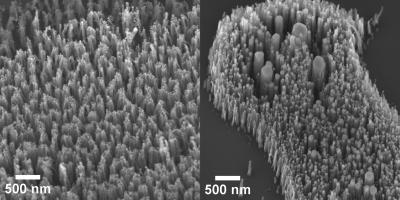Carbon nanofibers hold promise for technologies ranging from medical imaging devices to precise scientific measurement tools, but the time and expense associated with uniformly creating nanofibers of the correct size has been an obstacle – until now. A new study from North Carolina State University demonstrates an improved method for creating carbon nanofibers of specific sizes, as well as explaining the science behind the method.
"Carbon nanofibers have a host of potential applications, but their utility is affected by their diameter – and controlling the diameter of nanofibers has historically been costly and time-consuming," says Dr. Anatoli Melechko, an associate professor of materials science and engineering at NC State and co-author of a paper describing the study.
Specifically, the researchers have shown that nickel nanoparticles coated with a ligand shell can be used to grow carbon nanofibers that are uniform in diameter. Ligands are small organic molecules that have functional groups (parts of the molecule) that bond directly to metals. Nickel nanoparticles are of particular interest because – at high temperatures – they can serve as catalysts for growing carbon nanofibers.
"What we learned is that the ligand shell, which is composed of trioctylphosphine, undergoes chemical changes at high temperatures – gradually transforming into a graphite-like shell," says Dr. Joe Tracy, a co-author of the paper and assistant professor of materials science and engineering at NC State. "These 'graphitic' shells prevent the nickel nanoparticles from lumping together at elevated temperatures, which is a problem for high-temperature applications involving nanoparticles."

Images of carbon nanofibers grown from nickel nanoparticle catalysts: (left) without removing the ligands and (right) after removing the ligands from the nanoparticles before nanofiber growth. Note how the nanofibers grown from nanoparticles with ligands are more uniform in diameter and distribution.
(Photo Credit: Dr. Joe Tracy, North Carolina State University)
Using nanoparticles to grow nanofibers is useful, because the fibers tend to have the same diameter as the nanoparticles they are growing from. If you need nanofibers that are 20 nanometers (nm) in diameter, you would simply use nanoparticles that are 20 nm in diameter as your catalyst.
"This is why controlling the diameter of the nanoparticles is important. If they begin to lump together at high temperatures, you end up growing nanofibers of many different, larger sizes," Melechko says. "This research gives us a better fundamental understanding of the relationship between nickel nanoparticles, ligands and carbon nanofiber synthesis."
Using nanoparticles to grow nanofibers has another benefit – it allows you to define where the nanofibers grow and how they are arranged. If you need the nanofibers to grow in a specific pattern, you would arrange the nanoparticles in that pattern before growing the fibers.
Source: North Carolina State University